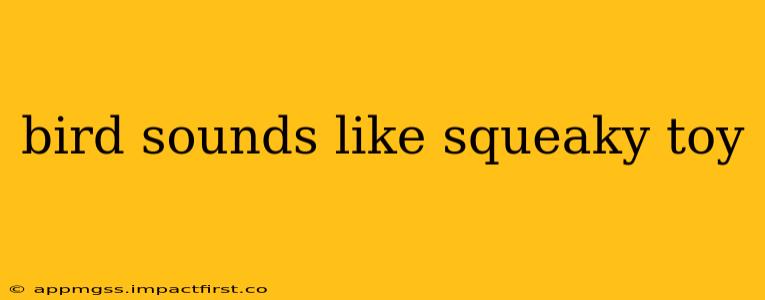Many birds produce sounds that can be surprisingly similar to a squeaky toy. This isn't just a matter of subjective interpretation; certain bird species have calls that genuinely share acoustic characteristics with those familiar plastic toys. This article will explore various bird species whose vocalizations might remind you of a squeaky toy, offering insights into identification and the reasons behind these unique sounds.
What Kinds of Birds Sound Like Squeaky Toys?
Several bird species, across various families and habitats, might evoke the sound of a squeaky toy. The specific call varies, depending on the species and the context (alarm calls are often different from contact calls, for instance). However, the shared characteristic is a high-pitched, often repetitive, and somewhat shrill sound.
Some birds whose calls might be described as "squeaky toy-like" include:
- House Wrens: These tiny, energetic birds are known for their loud, bubbly, and often repetitive songs that can sound quite squeaky, especially at higher pitches.
- Chickadees: Certain chickadee calls, particularly their "chick-a-dee-dee-dee" calls, can contain notes that resemble the squeak of a toy. The emphasis on higher frequencies is key here.
- Smaller warbler species: Many smaller warbler species have high-pitched, thin calls that, when heard from a distance or in particular contexts, can sound reminiscent of a squeaky toy. Pinpointing the exact species requires more detailed listening and observation.
- Some finches: Depending on the species and its individual variations, some finches can produce sharp, high-pitched notes that resemble a squeaky toy.
Why Do Birds Make These Squeaky Sounds?
The reasons behind these squeaky sounds vary depending on the species and the context. However, several factors contribute:
- Mating calls: High-pitched sounds travel further, especially in dense vegetation. Squeaky calls might be used to attract mates from a distance.
- Alarm calls: These calls alert other birds to danger. A high-pitched, jarring sound is effective in startling a potential predator.
- Contact calls: These are used to maintain contact with other birds within a flock or family group. A repetitive, squeaky call can be easily heard, even in noisy environments.
- Territorial defense: Birds might use squeaky calls to warn other birds off their territory. The shrill nature of the sound can serve as a clear warning signal.
How Can I Identify a Bird Based on its Squeaky Sound?
Identifying a bird solely based on a squeaky sound can be challenging, as many species may produce similar vocalizations. However, combining the sound with other observational clues greatly improves identification accuracy:
- Location: Where did you hear the sound? Different birds inhabit different habitats.
- Time of year: Some calls are seasonal, related to breeding or migration.
- Other sounds: Did the bird make any other calls? A complete vocal repertoire is more diagnostic than a single note.
- Visual identification: If possible, try to spot the bird. Even a glimpse can drastically narrow down possibilities. Using binoculars is invaluable here.
- Bird identification apps: Numerous apps (like Merlin Bird ID) use sound recognition to help identify birds.
What are some common misconceptions about birds and their sounds?
One common misconception is that all birds of the same species have identical sounds. Individual variations, age, and environmental factors all influence vocalizations. Another misconception is that only certain species use “squeaky” sounds. While some species are more prone to high-pitched calls, a wider variety of birds incorporate such sounds within their repertoire.
Is there a difference between a squeak and a chirp?
While both “squeak” and “chirp” describe high-pitched bird sounds, a squeak tends to be harsher and more abrupt, while a chirp is often softer and more melodic, generally consisting of short, repeated notes. However, these distinctions are somewhat subjective and vary based on individual perception and species-specific sounds.
By carefully observing your surroundings and listening closely to the specific characteristics of the sound, combined with the use of reliable bird identification resources, you can significantly improve your chances of identifying the squeaky bird serenading you. Remember that patience and observation are key to unlocking the mysteries of avian vocalizations!
